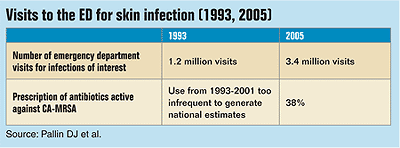ED visits for skin, tissue infections on the rise
Although an epidemic has been confirmed, the majority of cases have been mild and are not cause for alarm.
Emergency department physicians are seeing more visits for skin infections since the occurence of community-associated methicillin-resistant Staphylococcus aureus, according to recently published data.
“MRSA infections used to occur only in hospitals and other health care facilities, but since the 1990s, we have seen cases in patients with no exposure to the health care environment,” Daniel J. Pallin, MD, MPH, told Infectious Diseases in Children.
According to Pallin, of the departments of emergency medicine at Brigham and Women’s Hospital and Children’s Hospital Boston, recent study data have shown that CA-MRSA has become the most common bacterium causing abscesses among ED patients.
“Until our study, what we didn’t know was whether more people were getting sick with these infections, or if it’s just that a different bacterium is causing the infections with the same number of people getting ill,” Pallin said.
Pallin and colleagues set out to test the hypotheses that ED visits for skin and soft tissue infections occurred more frequently during the emergence of CA-MRSA, and that physicians were more often choosing to treat with antibiotics typically used against CA-MRSA.
Their results were published in the February issue of Annals of Emergency Medicine.

Epidemic confirmed
The researchers examined merged data from the National Hospital Ambulatory Care Survey between 1993 and 2005 and identified ED visits with diagnoses commonly caused by S. aureus, such as cellulitis, abscess and impetigo.
They found these infections of interest were diagnosed at 1.2 million visits in 1993, compared with 3.4 million visits in 2005. As a proportion of all ED visits, these infections were diagnosed 1.35% of the time in 1993 compared with 2.98% of the time in 2005.
When patients were prescribed antibiotics during these visits, antibiotics typically active against CA-MRSA were prescribed more frequently by 2005 (38%) than they had been from 1993 to 2001 (95% CI, 30-45; P<.001).
“Our study shows that there is indeed an epidemic,” Pallin said. “We found that the rate of ED visits for skin and soft-tissue infections nearly tripled from 1993 to 2005. We also found that doctors are now treating skin and soft-tissue infections with antibiotics that are effective against CA-MRSA, when in the past, they didn’t.”
Despite confirmation of an epidemic, the public should not be alarmed because the majority of the cases have been mild, according to Pallin. However, surveillance of staphylococci is important, and purulent skin infections should be cultured and treated as necessary.
“Although we think trimethoprim-sulfamethoxazole is the best choice when antibiotics are needed for patients with abscesses, it’s important to understand that most abscesses should be treated with incision and drainage, not antibiotics,” Pallin said. “For skin infections that are not abscesses, we still don’t know if MRSA plays a role.” – by Cara Dickinson
For more information:
- Pallin DJ, Egan DJ, Pelletier AJ, et al. Increased U.S. emergency department visits for skin and soft tissue infections, and changes in antibiotic choices, during the emergence of community-associated methicillin-resistant Staphylococcus aureus. Ann Emerg Med. 2008;doi:10.1016/j.annemergmed.2007.12.004.
